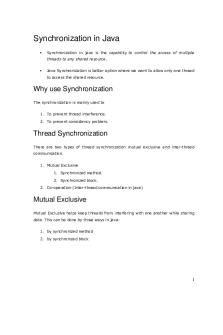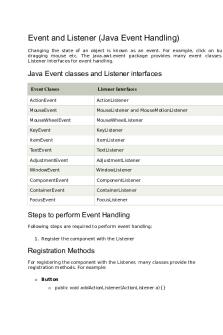Exercises about recursion in Java PDF

| Title | Exercises about recursion in Java |
|---|---|
| Course | Algorithms and Data Structures |
| Institution | University of Greenwich |
| Pages | 2 |
| File Size | 43 KB |
| File Type | |
| Total Downloads | 38 |
| Total Views | 190 |
Summary
The assignment about recursion in Java programming language...
Description
1/ Given n of 1 or more, return the factorial of n, which is n * (n-1) * (n-2) ... 1. Compute
the result recursively (without loops). 2/ We have a number of bunnies and each bunny has two big floppy ears. We want to
compute the total number of ears across all the bunnies recursively (without loops or multiplication). 3/ We have bunnies standing in a line, numbered 1, 2, ... The odd bunnies (1, 3, ..) have the normal 2 ears. The even bunnies (2, 4, ..) we'll say have 3 ears, because they each have a raised foot. Recursively return the number of "ears" in the bunny line 1, 2, ... n (without loops or multiplication). 4/ The fibonacci sequence is a famous bit of mathematics, and it happens to have a recursive definition. The first two values in the sequence are 0 and 1 (essentially 2 base cases). Each subsequent value is the sum of the previous two values, so the whole sequence is: 0, 1, 1, 2, 3, 5, 8, 13, 21 and so on. Define a recursive fibonacci(n) method that returns the nth fibonacci number, with n=0 representing the start of the sequence. 5/ We have triangle made of blocks. The topmost row has 1 block, the next row down has 2 blocks, the next row has 3 blocks, and so on. Compute recursively (no loops or multiplication) the total number of blocks in such a triangle with the given number of rows. 6/ Given a non-negative int n, return the sum of its digits recursively (no loops). Note that mod (%) by 10 yields the rightmost digit (126 % 10 is 6), while divide (/) by 10 removes the rightmost digit (126 / 10 is 12). 7/ Given a non-negative int n, return the count of the occurrences of 7 as a digit, so for example 717 yields 2. (no loops). Note that mod (%) by 10 yields the rightmost digit (126 % 10 is 6), while divide (/) by 10 removes the rightmost digit (126 / 10 is 12). 8/ Given a non-negative int n, compute recursively (no loops) the count of the occurrences of 8 as a digit, except that an 8 with another 8 immediately to its left counts double, so 8818 yields 4. Note that mod (%) by 10 yields the rightmost digit (126 % 10 is 6), while divide (/) by 10 removes the rightmost digit (126 / 10 is 12). 9/ Given an array of ints, compute recursively if the array contains a 6. We'll use the convention of considering only the part of the array that begins at the given index. In this way, a recursive call can pass index+1 to move down the array. The initial call will pass in index as 0. array6([1, 6, 4], 0) → true array6([1, 4], 0) → false array6([6], 0) → true
count8(8) → 1 count8(818) → 2 count8(8818) → 4...
Similar Free PDFs

Recursion
- 11 Pages

Recursion
- 18 Pages

Loopsin Java - Loops in Java
- 9 Pages

Synchronization in Java
- 11 Pages

Multithreading in Java
- 12 Pages

Access Specifiers in Java
- 4 Pages

Event Handling IN JAVA
- 6 Pages

Programmazione in Java Script
- 177 Pages

Exercises in Logic III
- 3 Pages

De ATP 4 Recursion
- 2 Pages

Klassen und Objekte in Java
- 5 Pages

Text Based Game in java
- 3 Pages
Popular Institutions
- Tinajero National High School - Annex
- Politeknik Caltex Riau
- Yokohama City University
- SGT University
- University of Al-Qadisiyah
- Divine Word College of Vigan
- Techniek College Rotterdam
- Universidade de Santiago
- Universiti Teknologi MARA Cawangan Johor Kampus Pasir Gudang
- Poltekkes Kemenkes Yogyakarta
- Baguio City National High School
- Colegio san marcos
- preparatoria uno
- Centro de Bachillerato Tecnológico Industrial y de Servicios No. 107
- Dalian Maritime University
- Quang Trung Secondary School
- Colegio Tecnológico en Informática
- Corporación Regional de Educación Superior
- Grupo CEDVA
- Dar Al Uloom University
- Centro de Estudios Preuniversitarios de la Universidad Nacional de Ingeniería
- 上智大学
- Aakash International School, Nuna Majara
- San Felipe Neri Catholic School
- Kang Chiao International School - New Taipei City
- Misamis Occidental National High School
- Institución Educativa Escuela Normal Juan Ladrilleros
- Kolehiyo ng Pantukan
- Batanes State College
- Instituto Continental
- Sekolah Menengah Kejuruan Kesehatan Kaltara (Tarakan)
- Colegio de La Inmaculada Concepcion - Cebu



